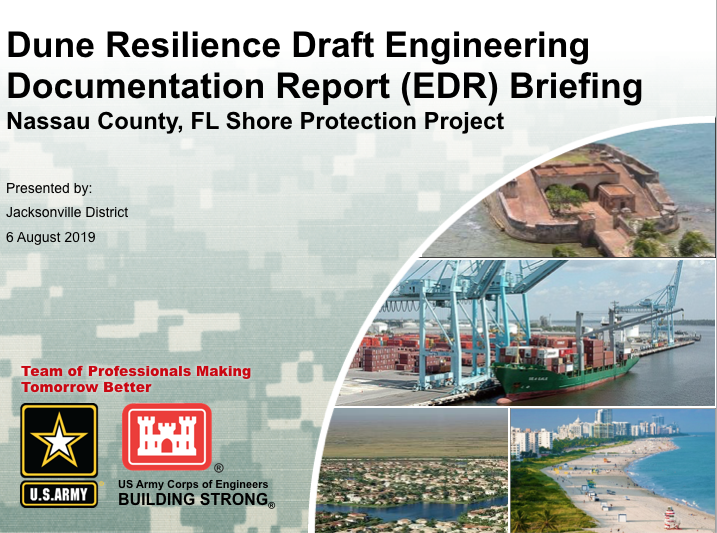Submitted by Suanne Z. Thamm
Reporter – News Analyst
August 12, 2019
On August 6, 2019 a briefing team from the Jacksonville Army Corps of Engineers Office presented the Fernandina Beach City Commission (FBCC) with an overview of a draft report representing the Corps’s latest recommendations for preventing coastal storm damage. The briefing team consisted of Project Manager Ms. Jackie Keiser, Project Manager Mr. Beau Corbett, and Planning Lead Mr. Marty Durkin.

Over time and with experience the Corps has developed strategies that go beyond beach renourishment following storms to recommending relatively low-cost measures to provide protection in advance of major storms.
According to their draft report:
“The United States Army Corps of Engineers (USACE) Jacksonville District, in partnership with local sponsors, has been implementing beach nourishment projects in Florida since 1969. The designs for most of these projects were developed from the 1960’s through the 1980’s. The majority of these projects were designed to control beach erosion and prevent the landward retreat of the shoreline that would cause property and infrastructure damage. The general understanding at the time was that that the best way to address the problem of landward erosion was to build a wider beach berm. Dunes were considered in the plan formulation process for these project, but typically were eliminated from consideration. This is because dunes were thought to only reduce storm surge flooding and vertical erosion which were not considered to be significant problems along the coast in most project areas. Beach recreation was also an important consideration in the development of these projects. The general understanding at the time was that wider beach berms would increase recreational opportunities while dunes would take up beach space that could otherwise provide recreational value. …
“The state of the science of coastal engineering has evolved to recognize that dunes are integral components of a beach system and play a critical role in reducing damages. Observations of how dunes have performed during recent storm events as well as research conducted by ERDC and others have led to an improved understanding of the how the dune and beach berm function as one interconnected system and the role that dunes play in storm response and overall beach morphology. It is now understood that dunes not only reduce storm surge flooding, but they contribute to and supplement the erosion damage reduction provided by berms. Additionally, the established root systems of vegetated dunes better withstand erosion than dunes consisting of sand alone. When the beach is actively eroded during storms, sand removed from the dunes is deposited onto the beach berm, serving to renourish the beach with an immediate natural sand source. They also serve as the ultimate line of defense against storm surge inundation by acting as a natural buffer to protect inland infrastructure. In addition to being integral to a beach’s storm damage reduction function, dunes provide important habitat for many plants and animals.”
The following three recommendations were presented for the portion of city beaches between Fort Clinch and Sadler Road:
Dune Incorporation with Vegetation. Dune incorporation along the entire length of the project. Dunes could be constructed as part of the project in the event that the existing dune becomes eroded in the future. The volume of sand to be placed in the dune template, should it erode, would be treated as part of the project’s advanced fill volume. Existing dune gap closures could be constructed separately and would include planting of native dune vegetation.
Vehicle Access Modifications. Modifications for two vehicle access points that include raising elevations, a vehicle mat, and an emergency stockpile of sand are recommended.


Pedestrian Access Modifications with sand fencing and boardwalks. Placing sand fencing along the side of the walkthrough to trap material in the access and help it to maintain a higher elevation. Approximately 50 feet of wooden sand fence would be needed at 25 public access points for a total of 1.250 feet of sand fence. Two boardwalks are recommended at the Dolphin Avenue and Atlantic Avenue parking lots.

The USACE recommends the steps listed above as positive steps to ensure dune resilience. These recommendations are currently making their way through the various USACE approval steps. Final approval is anticipated in December 2019.
Assuming official adoption of the recommendations, the city would be required to implement the recommendations or risk losing renourishment assistance from the USACE in those areas where they failed to implement or maintain the recommendations.
Vice Mayor Len Kreger reminded commissioners and the audience that these are only preliminary recommendations at this time. Commissioner Chip Ross stressed that the city and the county have the best deal in the country when it comes to federal support for beach renourishment.

Has the FBCC ever heard of the Atlantic Beach, NC restoration of its dunes? Since 1964 they’ve been using discarded Christmas trees (all lights and decorations removed) to build dunes for the protection of their beaches. An article by Jennifer Allen in the Coastal Review Online, coastalreview.org, explains their successful use of discarded Christmas trees for dune restoration. It’s a fairly inexpensive and highly effective way to restore dunes AND it smells great!